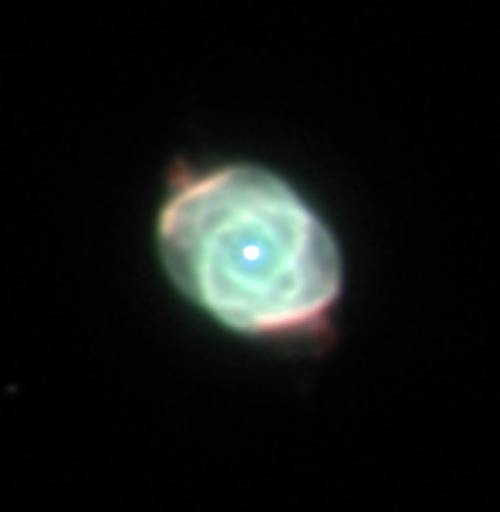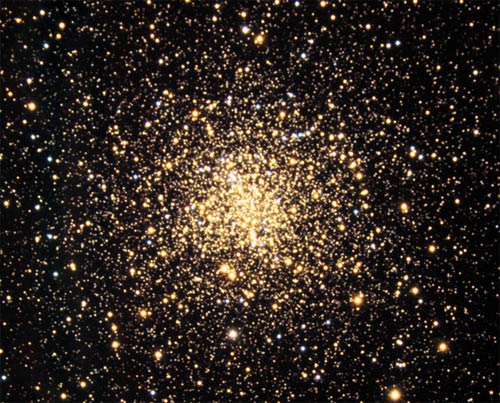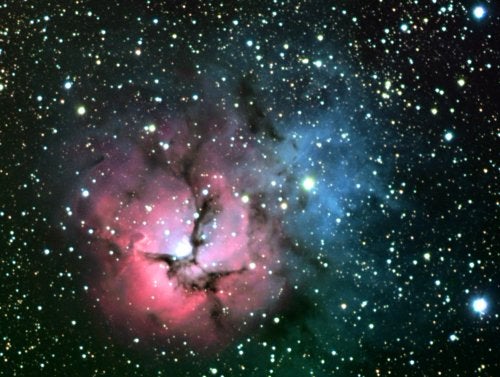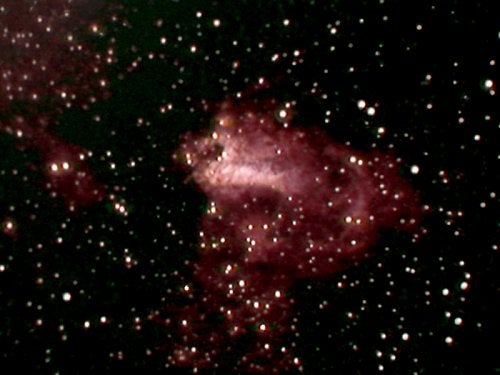About a third of the way from the head of Draco the Dragon to Polaris the North Star, lies the Cat’s Eye Nebula (NGC 6543), a planetary nebula made famous by a colorful picture from the Hubble Space Telescope. Amateur telescopes show it as an irregular blue-green disk about the size of Saturn. NGC 6543’s position in a relatively barren area makes it a bit tricky to find.
NOAO
Cat’s Eye Nebula (NGC 6543)
About a third of the way from the head of Draco the Dragon to Polaris the North Star, lies the Cat’s Eye Nebula (NGC 6543), a planetary nebula made famous by a colorful picture from the Hubble Space Telescope. Amateur telescopes show it as an irregular blue-green disk about the size of Saturn. NGC 6543’s position in a relatively barren area makes it a bit tricky to find.
About a third of the way from the head of Draco the Dragon to Polaris the North Star, lies the Cat’s Eye Nebula (NGC 6543), a planetary nebula made famous by a colorful picture from the Hubble Space Telescope. Amateur telescopes show it as an irregular blue-green disk about the size of Saturn. NGC 6543’s position in a relatively barren area makes it a bit tricky to find.
At a distance of 7,000 light-years, M4 is one of the closest globular clusters. However, it’s not as easy to see as its proximity might imply. It’s so large (more than half the apparent size of the Moon), its light is spread out. Under dark skies, however, it’s possible to spot this shy globular through binoculars, and sharp-eyed observers even can see it with their naked-eyes.
NOAO
M4
At a distance of 7,000 light-years, M4 is one of the closest globular clusters. However, it’s not as easy to see as its proximity might imply. It’s so large (more than half the apparent size of the Moon), its light is spread out. Under dark skies, however, it’s possible to spot this shy globular through binoculars, and sharp-eyed observers even can see it with their naked-eyes.
At a distance of 7,000 light-years, M4 is one of the closest globular clusters. However, it’s not as easy to see as its proximity might imply. It’s so large (more than half the apparent size of the Moon), its light is spread out. Under dark skies, however, it’s possible to spot this shy globular through binoculars, and sharp-eyed observers even can see it with their naked-eyes.
Trifid Nebula (M20)
Among one of the many famous objects in Sagittarius is the Trifid Nebula (M20). Through moderate-size apertures, the Trifid appears as little more than a hazy patch centered on the double star HN 40 (8th and 9th magnitudes). A 10-inch or larger telescope is needed to trace the dark lanes of dust that trisect it and give rise to its popular name.
Among one of the many famous objects in Sagittarius is the Trifid Nebula (M20). Through moderate-size apertures, the Trifid appears as little more than a hazy patch centered on the double star HN 40 (8th and 9th magnitudes). A 10-inch or larger telescope is needed to trace the dark lanes of dust that trisect it and give rise to its popular name.
Omega Nebula (M17)
On dark nights, the Omega Nebula can be seen through binoculars as a wedge-shaped object. Larger instruments reveal its arch shape, like a Greek capital omega, from which comes its popular name.
On dark nights, the Omega Nebula can be seen through binoculars as a wedge-shaped object. Larger instruments reveal its arch shape, like a Greek capital omega, from which comes its popular name.
Ian Ridpath is the author of The Monthly Sky Guide (Cambridge University Press) and the Princeton Field Guide to Stars and Planets (Princeton University Press). He can be reached via www.ianridpath.com.













